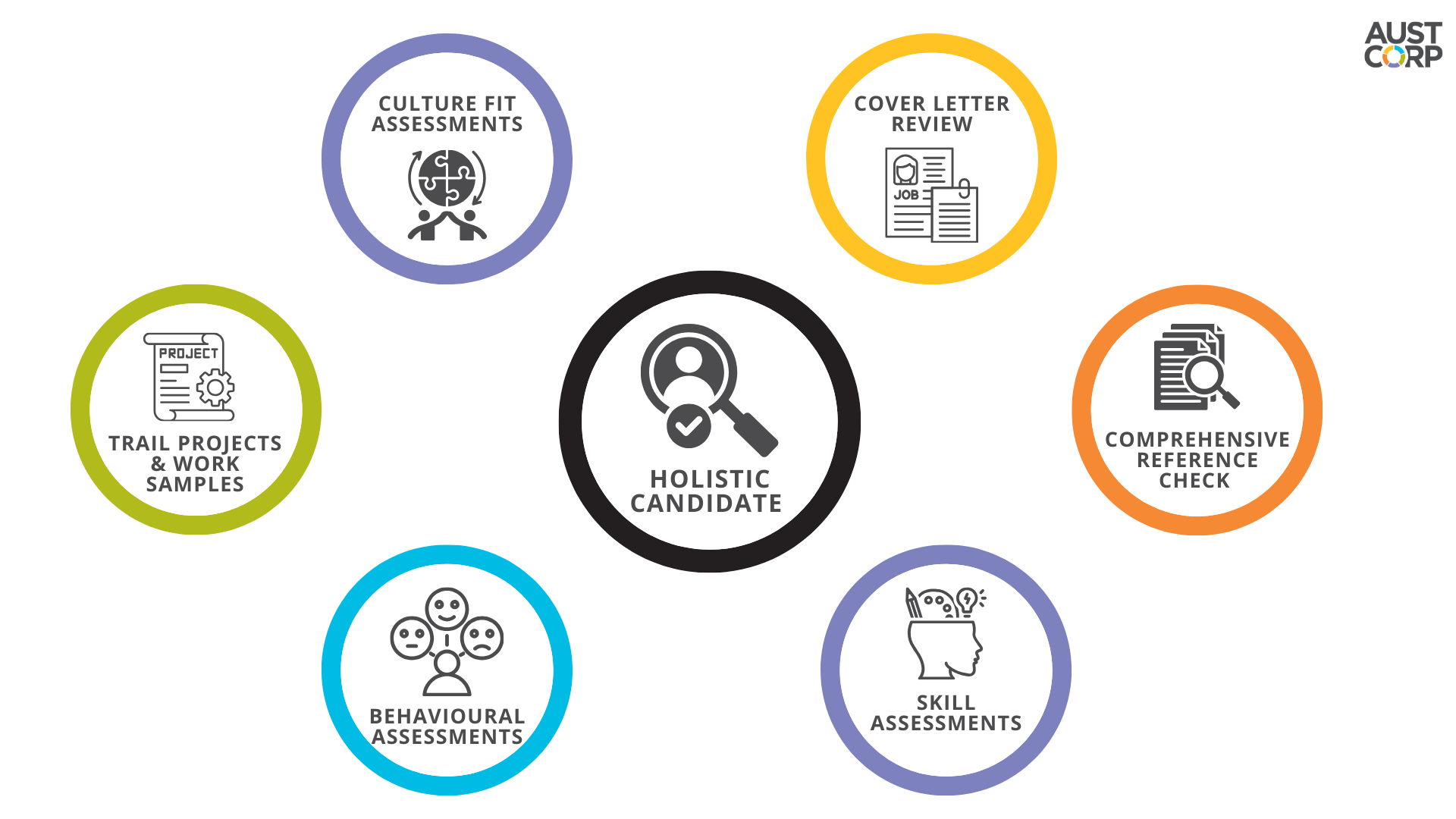
Mastering the Art of Resume Assessment: Expert Tips for Effective Candidate Evaluation
Have you ever felt overwhelmed while sifting through a stack of resumes? You're not alone. A recent study reveals that nearly 89% of Australian employers encounter difficulties in securing top talent, with 30% attributing this to ineffective resume screening. In today's competitive job market, relying solely on resumes can be like reading a book by its cover—you might miss out on some genuinely great candidates.
At AustCorp Executive, we understand the challenges you face. That's why we've crafted this comprehensive guide to help you master the art of resume assessment. From identifying critical skills and experiences to leveraging technology and avoiding common pitfalls, we'll walk you through the process. By the end of this blog, you'll have the tools and knowledge to streamline your hiring process and find the perfect fit for your organisation.
Ready to revolutionise the way you evaluate resumes? Let's dive in and uncover the secrets to practical candidate evaluation.

The Importance of Holistic Candidate Evaluation
Relying solely on a candidate's resume can sometimes feel like trying to solve a puzzle with only half the pieces. While resumes provide a snapshot of a candidate's professional journey, they often miss the nuances that make someone the perfect fit for your team. That's where holistic candidate evaluation comes in—a strategy considering the whole person, not just their paper qualifications.
Traditional resume screening focuses heavily on hard skills, education, and work experience. However, this approach must focus on critical soft skills, cultural fit, and growth potential. By incorporating elements such as soft skills, cultural fit, and potential for growth into your evaluation process, you can gain a more comprehensive understanding of each candidate. This helps make better hiring decisions, reduces turnover rates, and fosters a more cohesive work environment.
Incorporating a Holistic Approach into Your Hiring Process - Understand the Full Picture
A resume provides a snapshot of a candidate's professional journey but only captures part of the story.
To get a comprehensive understanding of each candidate, consider the following:

Cover Letter Review:
Beyond checking for relevant skills and experience in the resume, pay attention to the candidate's communication style and enthusiasm featured within the Cover Letter. According to a CareerBuilder survey, 45% of employers say they are less likely to interview a candidate if they don't include a cover letter, and 30% find it a significant factor in hiring decisions. A well-crafted cover letter can reveal a candidate's motivation and attention to detail.
Skill Assessments:
Implement job-specific tests or simulations to evaluate technical proficiency. According to the latest data from the Society for Human Resource Management (SHRM), 82% of companies use some form of skill assessment during the hiring process, underscoring its importance in verifying technical capabilities. Additionally, companies that use skill assessments report a 24% higher quality of hire, highlighting the effectiveness of this method.
Behavioural Assessments:
Use structured questions that explore past experiences. This method helps understand how candidates have handled real-world situations, their problem-solving approaches, and their ability to work in a team. Questions could include:
"Can you describe when you had to learn a new skill quickly? How did you approach it?"
"Tell me about a situation where you had to adapt to a significant change at work. How did you handle it?"
Culture Fit Assessments:
Include questions about company values, preferred work style, and team dynamics. This step is vital as a poor cultural fit can lead to decreased job satisfaction and higher turnover rates. According to a study by the Harvard Business Review, up to 80% of employee turnover is due to poor hiring decisions related to cultural fit. Additionally, companies with established cultures see a 4x increase in revenue growth.
Comprehensive Reference Checks:
Reference checks should go beyond verifying employment dates and job titles. They are an opportunity to gather deeper insights into a candidate's performance and behaviour:
Performance Feedback: Ask about the candidate's strengths, weaknesses, and overall performance in their previous roles.
Soft Skills Assessment: Inquire about the candidate's communication skills, teamwork, leadership, and adaptability.
Cultural Fit: Discuss how the candidate fits into the previous company's culture and how they interacted with colleagues.
Trial Projects and Work Samples
For specific roles, especially those that are highly technical or creative, consider asking candidates to complete a trial project or submit work samples:
Realistic Projects: Assign a small project that reflects the actual work they would be doing. This helps you assess their skills in a real-world context.
Work Samples: Request previous work samples, such as reports, designs, or code, to evaluate their quality and relevance.
Continuous Feedback and Improvement
Integrating a holistic approach into your hiring process is a collaborative effort. Continuously gather feedback and refine your methods:
Candidate Feedback: Collect feedback from candidates about their experience with your hiring process to identify areas for improvement.
Internal Feedback: Gather input from hiring managers and team members about the effectiveness of the holistic evaluation techniques.
Metrics and Analysis: Track key hiring metrics, such as time-to-hire, quality of hire, and employee retention, to measure the impact of your holistic approach.
What else to consider for a comprehensive evaluation:
Standardisation: Use consistent evaluation criteria and rubrics for all candidates to ensure a fair and unbiased assessment. This approach mitigates unconscious bias and helps make objective comparisons.
Multiple evaluators: Involve a diverse panel of interviewers from different departments to gain a well-rounded perspective on the candidates. This collaborative approach can uncover different strengths and potential red flags that a single evaluator might miss.
Candidate Experience: Ensure a positive candidate experience with clear communication and timely updates.
Step-by-Step Guide to a Holistic Candidate Evaluation

Step 1: Define Your Criteria
To be effective at candidate evaluations, you must know what kind of person you seek to fill your open roles. Measuring someone's skill and experience can be challenging without first setting standards and minimum requirements.
Once you have written your job description, dive deeper into what your ideal candidate looks like – this should include
Job Requirements: Must have Technical Skills, experience, and qualifications
Soft Skills: Consider the skills and attributes that current employers in the role or a similar role possess. Identify these skills and what they may look like in a potential candidate.
Cultural Drivers: Identify the key traits and values of your current team. When conducting phone and in-person interviews, looking for these traits and values in potential employers is crucial.
Preferred Qualifications: Identify the nice-to-have attributes that make a candidate stand out.
Clearly defining the experience and skills you want from your next hire makes it easier to determine when a qualified person has applied. You can continue to use your ideal candidate profile as a guidepost through the interview stage, and it can help you decide when comparing the top choices.
Step 2: Pre-Screening Questions:
You can streamline candidate evaluation by including pre-screen questions on your application. Two to three questions can help you immediately weed out applicants without minimum qualifications for your open roles.
Pre-screen questions serve as a gatekeeper. You know that any applicants that make it past this stage have at least the bare minimum requirements for your job. Pre-screen questions also save you time and guesswork when hiring quickly.
Remember that too many pre-screen questions can overwhelm applicants, cause a poor application experience, and even cause them to abandon your application. Include only a few relevant and meaningful questions on your application. Some things you might want to ask include:
Work availability
Required licenses, certifications, or degrees
Number of years of experience in a specific role or industry
Step 3: Use an Applicant Tracking System (ATS)
Leverage technology to streamline the initial screening process. An ATS can help:
Filter Resumes: Automatically filter out resumes that don't meet the essential criteria.
Highlight Keywords: Identify resumes that include relevant keywords and phrases.
Rank Candidates: Rank candidates based on their match with the job description.
Step 4: Perform an Initial Scan
Quickly scan each resume to see whether it's worth a deeper look. Focus on:
Candidate Location: Simple but essential – the first thing to look for if you are hiring for an in-person position is the candidate's location. If you get a qualified candidate who does not live nearby, don't rule them out just yet. It may be worth a conversation (Or at least an email or text) to see if they plan to relocate to your area.
Candidate Objective: Move to the summary or objective section if the resume has one. Look for keywords that help you determine if the candidate has the experience you're looking for and see if you can tell what next step the candidate wants to take in their career.
Minimum Qualifications: Pre-screen questions should help you determine whether someone meets your minimum qualifications, but double-check that the resume includes those must-haves you are looking for.
Work Experience: When reviewing work history, look for specific examples of a candidate's impact. Dig more deeply than the job title; consider how the candidate describes the roles and responsibilities. This section gives you a great idea of a candidate's track record as an employee. Look at the resume's story: Do you see someone constantly advancing on a career path or an inconsistent job hopper? Past behaviour is usually a good predictor of the future.
Growth Potential: A specific job history isn't the only indicator that someone might be successful in a role. Evaluate resumes for soft skills and growth potential. Soft Skills in unrelated positions might be more valuable than an employee who checks all the work history boxes but has no proven results or measurable professional growth.
Step 5: Look for Red Flags
As you review the details, be on the lookout for potential red flags, such as:
Frequent Job Changes: Multiple short-term positions without clear reasons.
Employment Gaps: Unexplained periods of unemployment.
Lack of Specificity: Vague descriptions of roles and responsibilities.
Poor Presentation: Spelling mistakes, poor formatting, and unprofessional email addresses.
Step 6: Use Checklists and Scorecards
Use checklists and scorecards to evaluate each resume to ensure consistency and fairness. This can include:
Basic Qualifications Checklist: A list of must-have qualifications that each resume must meet.
Scorecard: A points-based system to rate resumes on various criteria, such as experience, skills, and cultural fit.
Step 7: Phone Interview's
Sometimes, a resume might excite you about a candidate but leave you with a few questions. Don't make any assumptions about a candidate before asking some clarifying questions. You can do this during an initial phone interview to get more context before moving the candidate forward. This is especially important for clarifying any red flags you picked up or determining a brief cultural fit profile for the candidate before meeting them face-to-face.
Step 8: Shortlist Candidates
Create a shortlist of candidates who meet the criteria based on your evaluations. These are the resumes that should move forward to the interview stage. Ensure that:
Top Candidates: The top-scoring resumes are given priority.
Balanced List: The shortlist includes a mix of candidates with diverse experiences and backgrounds.
Step 9: Prepare for Interviews
Throughout our 27 years of experience, we have consistently found that a negative experience with people in the interview process was one of the top reasons candidates quit a job.
Preparing for interviews ahead of time helps you evaluate candidates more effectively and improves your chances of getting those top-choice candidates to say yes to your job offers.
Before the interview:
Review the Ideal Candidate profile and make sure you have a firm grasp of the role
Know what you need to evaluate and be able to answer any candidate questions that may arise.
Prepare your interview questions ahead of time.
Review the candidate's resume, cover letter, and any other relevant data you may have collected (like assessment reports or phone screen notes).
Share the candidate's information with other interviewers so everyone can walk in as prepared as you.
Interview Formats and Types: There are several ways to interview and get to know your candidates. Depending on the number of candidates you have and the nature of the role you are trying to fill, you will likely use more than one type and format.
Structured interviews are when an interviewer prepares a fixed set of questions to ask candidates and stays consistent with those questions.
Unstructured interviews are a more natural conversation style where the interviewer can follow their curiosity and ask more tailored questions.
Hybrid Interviews are a combination of both. These can take a little more skill as they require an interviewer to know when they should stay on course and when it's ok to deviate. This can be an excellent way to get to know your candidates deeper and ask all candidates the same primary questions. If you are new to interviewing, sticking to a more structured approach can be helpful.
Common Interview Questions:
Verification Interview Questions are used to verify a candidate's credentials and experience. They can be thought of as "fact-based questions". For Example: "What were your dates of employment?" or "What were your job responsibilities?".
Opinion interview questions ask about a candidate's perspective or opinion. They can provide valuable insight into how a candidate thinks, what motivates them, what values they hold, and how they solve problems.
Behavioural questions ask for examples of how a candidate has behaved in the past, like: "Tell me about the last time you received feedback and how you responded to it."
Most interviews will have a mix of verification, opinion, and behavioural questions. When deciding which questions are correct, return to your Ideal Candidate Profile. Review the desired skills, talents, and behaviours for the role — what questions will help you evaluate those criteria?
You can also match interview questions with your company's core values to ensure you're hiring people who align with your company culture.
Step 10: Further Evaluations:
If the role is complex or technical and requires additional evaluation, you may like to conduct further testing in a second interview to clarify the decision. This may include Behavioural Assessments, Personality Tests, Technical Tests, and situational judgement tests.
For Example, Many of our clients will implement skill-based tests within their interview process, requiring the candidate to complete a task using specific software or a complex task. By conducting this within the interview, you can confirm the skills and ability of the candidate to ensure quality starting.
Step 11: Follow-Up
After the interviews, follow up with candidates promptly. Keep in mind:
Feedback: Provide constructive feedback to those who need to move forward.
Next Steps: Communicate the following steps to those who are shortlisted.
Step 12: Reference and Background Checks
We know it can be tempting for employers to skip the background and reference checks when you're in a hurry to hire – but don't! You should conduct reference and background checks for many important reasons, like workplace safety, data verification, and improved team quality.
There are many types of background checks:
Criminal background checks
Drug screening
Employment and education verifications
Civil record checks
Driver record checks
Identity checks
Establish a list of necessary checks consistent with your profession and business ethics. For Example, a criminal history check is mandatory if the job involves working with children.
Reference checks, which involve talking to a candidate's previous managers or colleagues, can help you fact-check what you've learned about a candidate so far – which is important considering 40% of people lie on their resumes and three out of four employers have caught candidates in a lie. Be sure to ask specific questions about what you want about an applicant.
Final Thoughts
Effectively assessing candidate resumes is a critical component of the hiring process. By adopting a holistic approach, you can ensure that you're not just hiring candidates with the right qualifications but also those who will thrive within your company culture and contribute positively to your team. Understanding what to look for in a resume, leveraging technology, avoiding common pitfalls, and incorporating holistic evaluation techniques will help you streamline your hiring process and make more informed decisions.
At AustCorp Executive, we specialise in providing comprehensive recruitment solutions tailored to your specific needs. Our approach incorporates holistic candidate evaluation techniques to ensure we find the perfect fit for your organisation. By focusing on both the tangible skills and the intangible qualities of your candidates, we help you build a dynamic, cohesive team ready to drive your organisation forward.
Ready to transform your hiring process? Contact AustCorp Executive for a free consultation to discover how we can assist with your hiring needs. Let's work together to build a stronger, more successful team.
